- Premium features included
- No hidden costs or usage limits
- Scale from startup to enterprise


I’ve been using Mailchimp since 2018 (with some breaks in between), and figured it’s time to share what I’ve learned about this email marketing software. If you’re trying to figure out whether it’s worth the money, here’s my Mailchimp review and experience.
Mailchimp isn’t perfect. But I keep coming back to it because they’re one of the few email marketing platforms that genuinely care about small businesses and freelancers. You can manage 500 contacts with basic marketing automation on their free plan before they ask for payment. Quite charitable, even if it’s not as generous as some Mailchimp alternatives.
Mailchimp email marketing started as a basic email marketing tool in 2001. Ben Chestnut and Dan Kurzius founded it and bootstrapped the whole thing for almost 20 years until Intuit bought them for $12 billion in 2021—now known as Intuit Mailchimp.
These days it does way more than email—you’ve got multichannel campaigns, social media ads, landing pages, even SMS campaigns. They serve over 13 million users, from one-person shops to Fortune 500 companies.
The Mailchimp AI Creative Assistant has been particularly helpful for me—it helps with design when I’m stuck, and Mailchimp Send Time Optimization figures out when people are most likely to open your emails.
If you want the short version, here’s our Mailchimp breakdown for 2025:
Scroll down for a detailed price and feature breakdown.
Mailchimp handles the basics well—drag-and-drop editor, email scheduling, all that. But there are some nice touches too. Send Time Optimization suggests when to send one-off campaigns (don’t use it for automated email flows, though), helping to reach potential customers. Meanwhile, RSS feed campaigns are still there if you need them, and you can use RSS merge tags for more control.
If you’re doing ecommerce, heads up: those Product and product recommendations blocks only work if you’ve connected a supported store. Without a store connection, they won’t show up or pull any data.

Another important thing to know about their campaign editor: Mailchimp’s Legacy Builder (or the classic one) and New Builder don’t play nicely together.
They’re built on different systems, so templates made in the Legacy version don’t always open or edit cleanly in the New Builder. Things like layouts, blocks, fonts, or styling can break, shift or disappear—and you usually can’t move designs back the other way either.
Because Mailchimp is slowly sunsetting the Legacy Builder, users who want to switch often end up recreating old emails from scratch. That includes your own templates, brand styling, and custom layouts you’ve built over time.
On top of that, there’s over 260 pre-made email templates available in the New Builder, while the classic one—even with better HTML customization options—has only slightly over 130.
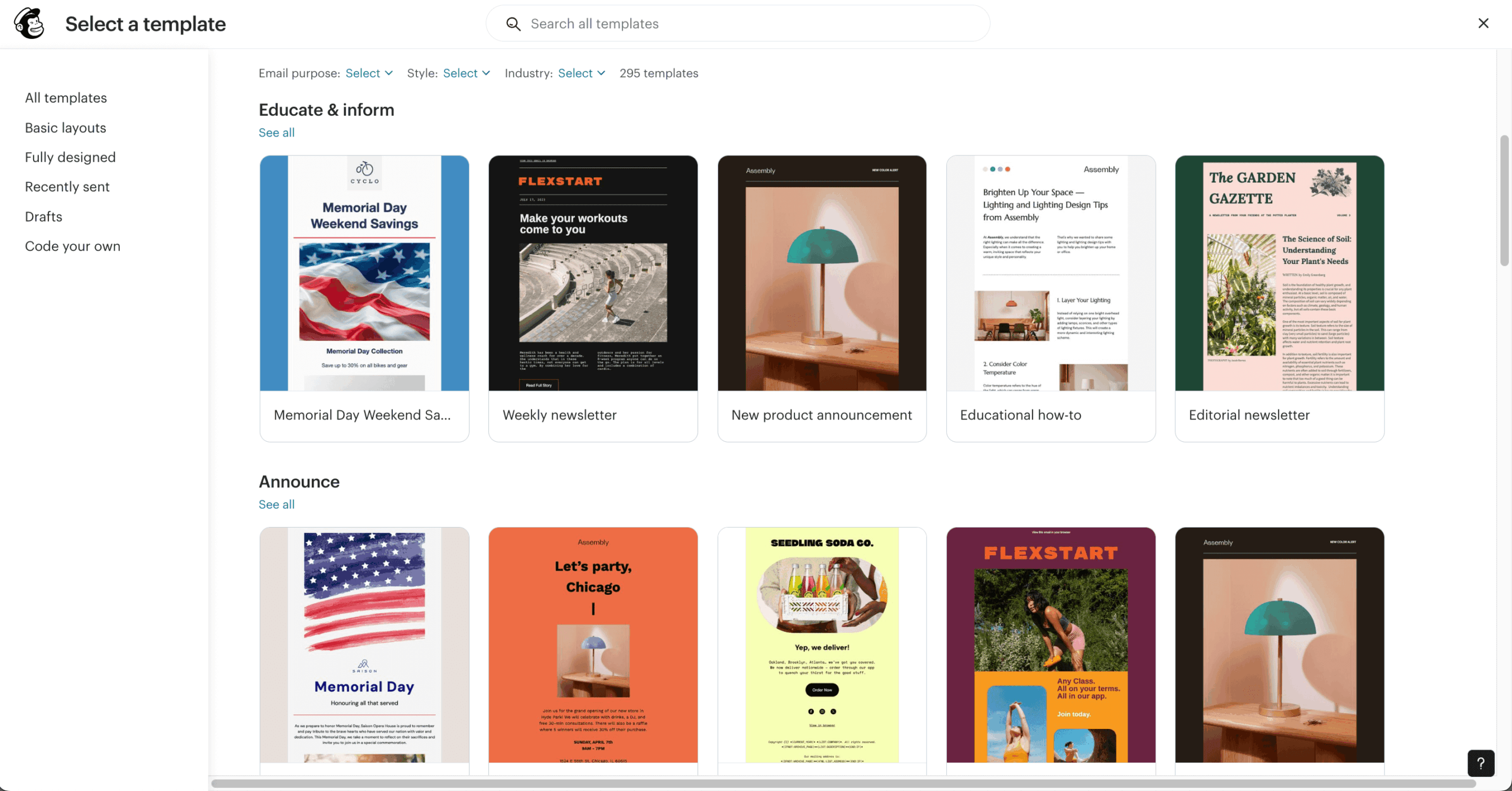
Quick tip: always check how your email campaign looks on mobile AND desktop separately in the new email builder. You can set different padding and margins for each device on certain content blocks, which has saved me from some embarrassing formatting issues. The drag‑and‑drop functionality really shines when you’re working with complex layouts.
I’ve run tons of email A/B tests—subject lines, from names, content, send times. You define test size, variants, and a measurement window; Mailchimp A/B testing reports variant performance so you can manually pick a winner. Don’t assume it auto-sends unless you specifically configure it that way on creation. I learned that one the hard way.
Here’s something important: Apple’s Mail Privacy Protection messes with open-based tests. I stick to clicks or revenue metrics now. You can do multivariate testing with the New Builder, but I keep it simple—too many variants and you’ll wait forever for meaningful results.
Also worth knowing: multivariate testing is only available on Premium. So if you’re on Essentials or Standard plans, you’re capped at A/B testing for most experiments.
Final heads-up: Inbox Preview runs through Litmus, and it uses tokens. Helpful, but not free—you burn through them quickly on paid plans if you’re testing a lot.
There are two main ways to personalize in Mailchimp: merge tags (including conditional ones) and dynamic content, which shows or hides blocks based on rules. Conditional merge tags work everywhere, while dynamic content in the new builder (Mailchimp has two builders) looks cleaner but needs a Standard plan or higher.
Always test your tags—Mailchimp has decent troubleshooting help for this. And since Apple’s privacy changes, I use click-based logic instead of opens for any behavior-driven personalization. Makes a real difference in accuracy.
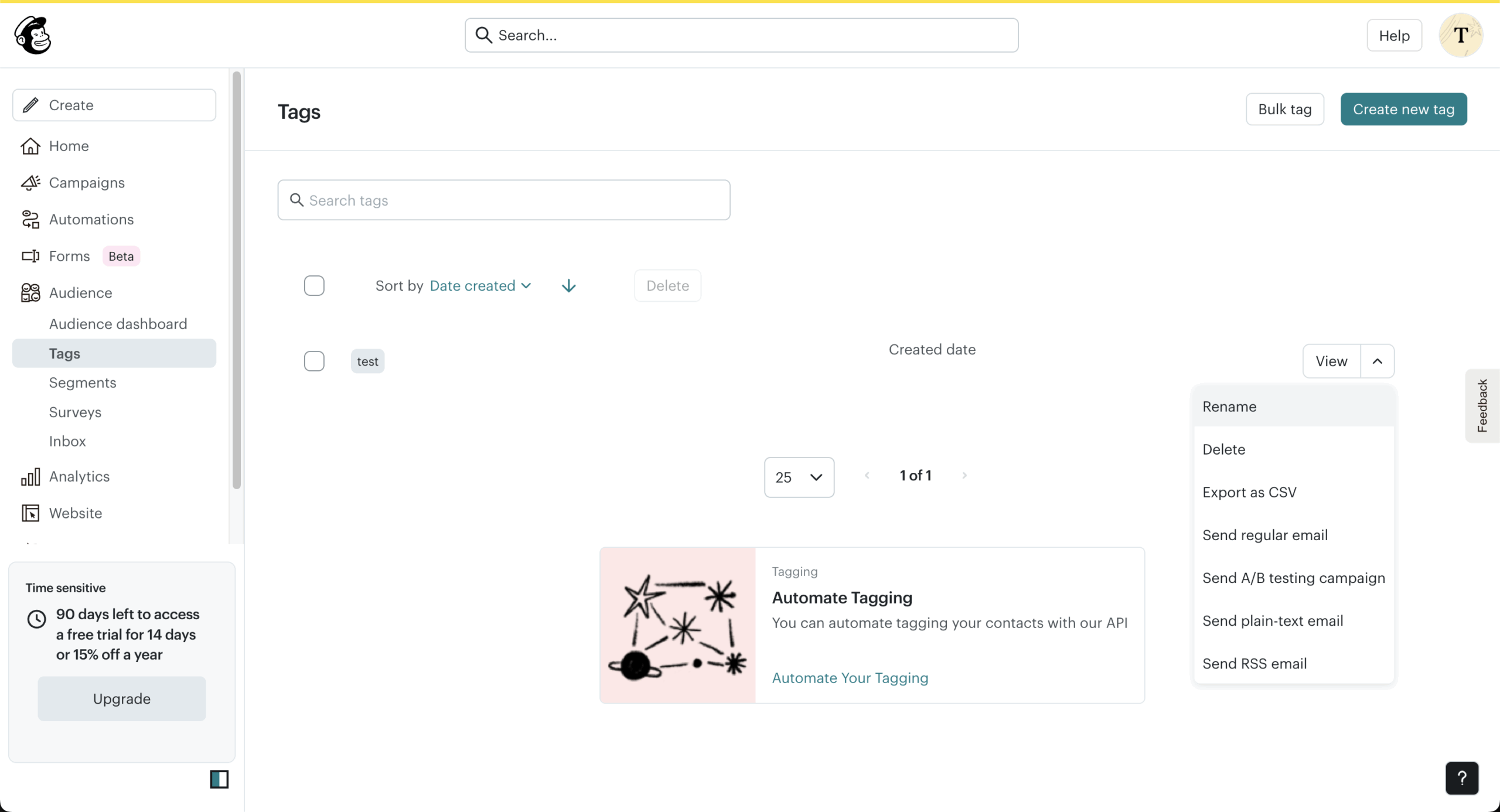
Email automation lets you build automations using pre-built journeys as starting points. You combine triggers (someone signs up, makes a purchase, gets tagged), rules (branches, delays), and actions (send email or SMS, add tags).
Two things that tripped me up: Send Time Optimization doesn’t work in automations, and some ecommerce-specific email blocks need a connected store even in automation flows.
The flow templates are decent starting points, but always check the trigger logic and goal tracking. Apple’s privacy stuff can cause weird issues if you’re not careful. I test everything and watch the per-node reporting to spot problems early. You can also set up transactional emails through the same system.
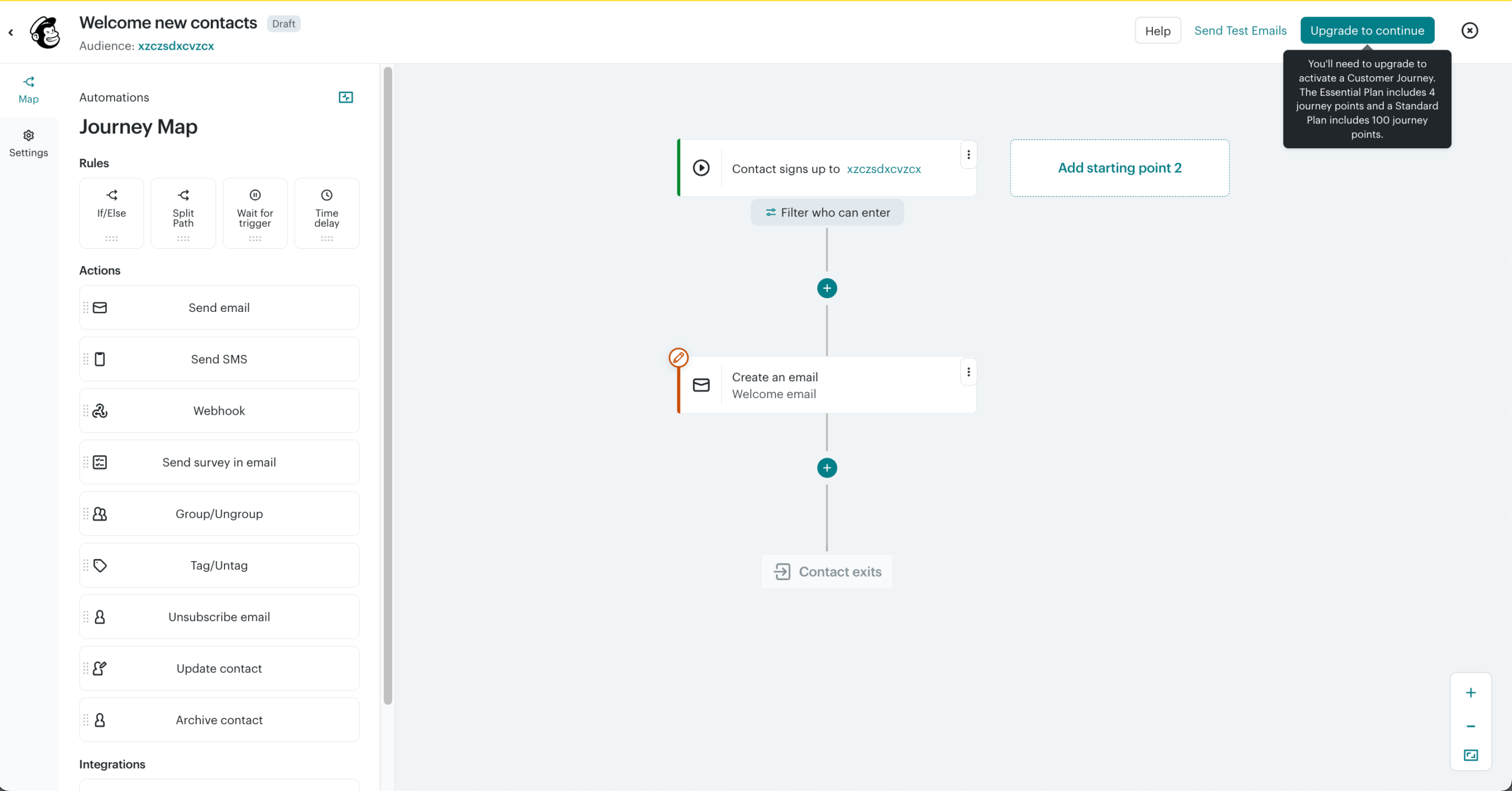
The landing pages in the new builder work as a basic website builder for quick promotional pages—forms, countdowns, product displays. They’re best for agile campaigns or gated content tied to your Mailchimp audience. For on-site capture, the pop-up forms are simpler—they’re hosted by Mailchimp and automatically tag contacts and add them to your lists (found in the audience tab).
The best part? You get to use the landing page builder, including unlimited pages already in the free plan. Plus, you get SEO tools and site visit analytics no matter your plan.
There are a few quirks worth noting, however. For starters, the landing page tool is hard to find—hidden under the Campaigns tab, and you only get around ten templates with no true “start from scratch” option. There’s also no A/B testing for landing pages and no custom HTML code support, so flexibility is limited.
Popup changed how I capture emails—they’re hosted by Mailchimp and connect directly to your audience, tags, and groups. No extra scripts needed, and attribution stays clean.
Mailchimp’s signup forms are one of those features I’ve used more than I expected. You can spin up embedded forms, pop-ups, or just a hosted page you link to. Everything syncs straight into my audience with tags or segments already applied, which saves me a ton of time later when I want to automate or target updates.
Customization is basic, though. You can tweak fields and colors, but you won’t get pixel-perfect control or advanced triggers. Still, for simple list growth without needing extra tools, Mailchimp’s forms are quick, reliable, and just work.
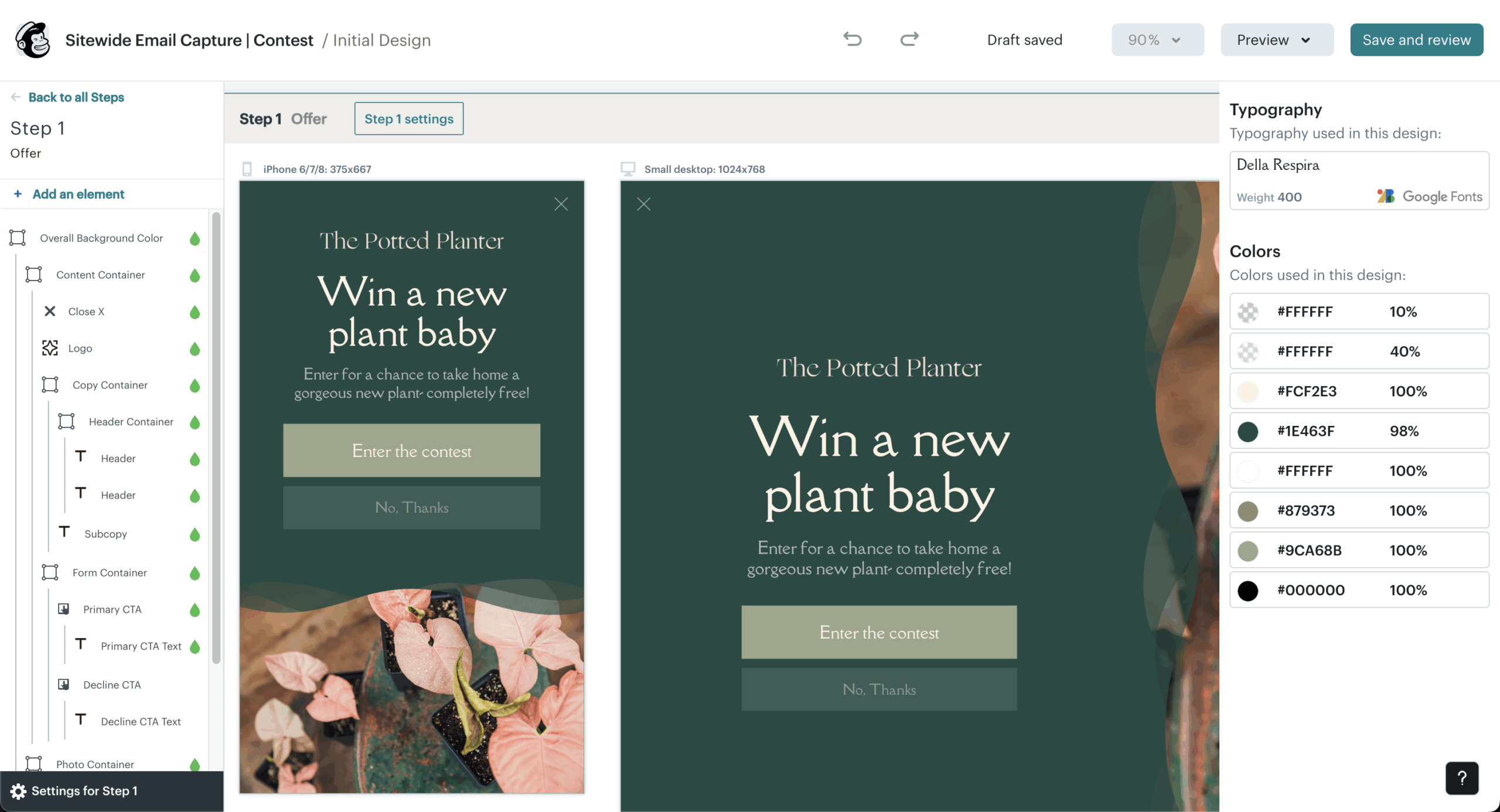
Surveys in Mailchimp are worth talking about as well. You can build multi-question surveys with different formats—multiple choice, rating scales, open text fields, you name it—and Mailchimp will automatically tag contacts based on how they answer.
You can also drop the survey right into a campaign using the Survey email block, send it out, and responses start tying directly back to individual contact profiles.
For quick insight, I’ll sometimes embed a single click-to-vote question using merge tags, but full surveys give you way more flexibility when you need real customer input. The results are easy to review inside reports, and if you work with data, you can pull everything via Mailchimp’s API.
Because responses are mapped to known contacts, you get a full loop (questions → answers → tags → segmentation) without needing extra tools or exporting spreadsheets. Works as expected, no notes.
My system revolves around tags (labels I create), groups (interests subscribers choose), and segments (filters based on any audience data). I let forms and surveys add tags automatically, then build saved segments for targeting and automation triggers. The platform helps manage duplicate contacts and inactive contacts effectively.
You can combine behaviors (last purchase, campaign activity) with fields and location data in segments. I try to keep things simple—fewer tags, clearer names, and a consistent set of saved segments. It cuts down on confusion and keeps targeting straightforward. The segmentation options are pretty extensive feature-wise.

I’ve built some complex segments using engagement data, ecommerce activity, location, signup source, language, tags, groups—you name it. They update automatically too.
Language segments are handy—Mailchimp detects language preference at signup. Save the segments you use repeatedly, name them consistently, and avoid open-based logic since Apple’s changes.
Pro tip: create “evergreen” segments like “hasn’t purchased in 90 days BUT clicked the last two emails” and use them everywhere. When you edit them, the changes apply to all your campaigns and automations.
The reporting tools cover campaigns, automations, and surveys. You get click tracking and open tracking (less reliable thanks to Apple). The email tracking features give you the data you need, though I’ve learned to focus more on clicks than opens these days.
I’ve set up Custom Reports for metrics I care about—click-to-open rate, revenue per recipient, device breakdown. And Comparative Reports help me spot patterns across campaigns.
Click Maps are great for diagnosing problems. Mailchimp can handle image maps (multiple links on one image) and shows clicks for each link. Really helpful for finding dead spots in your design.
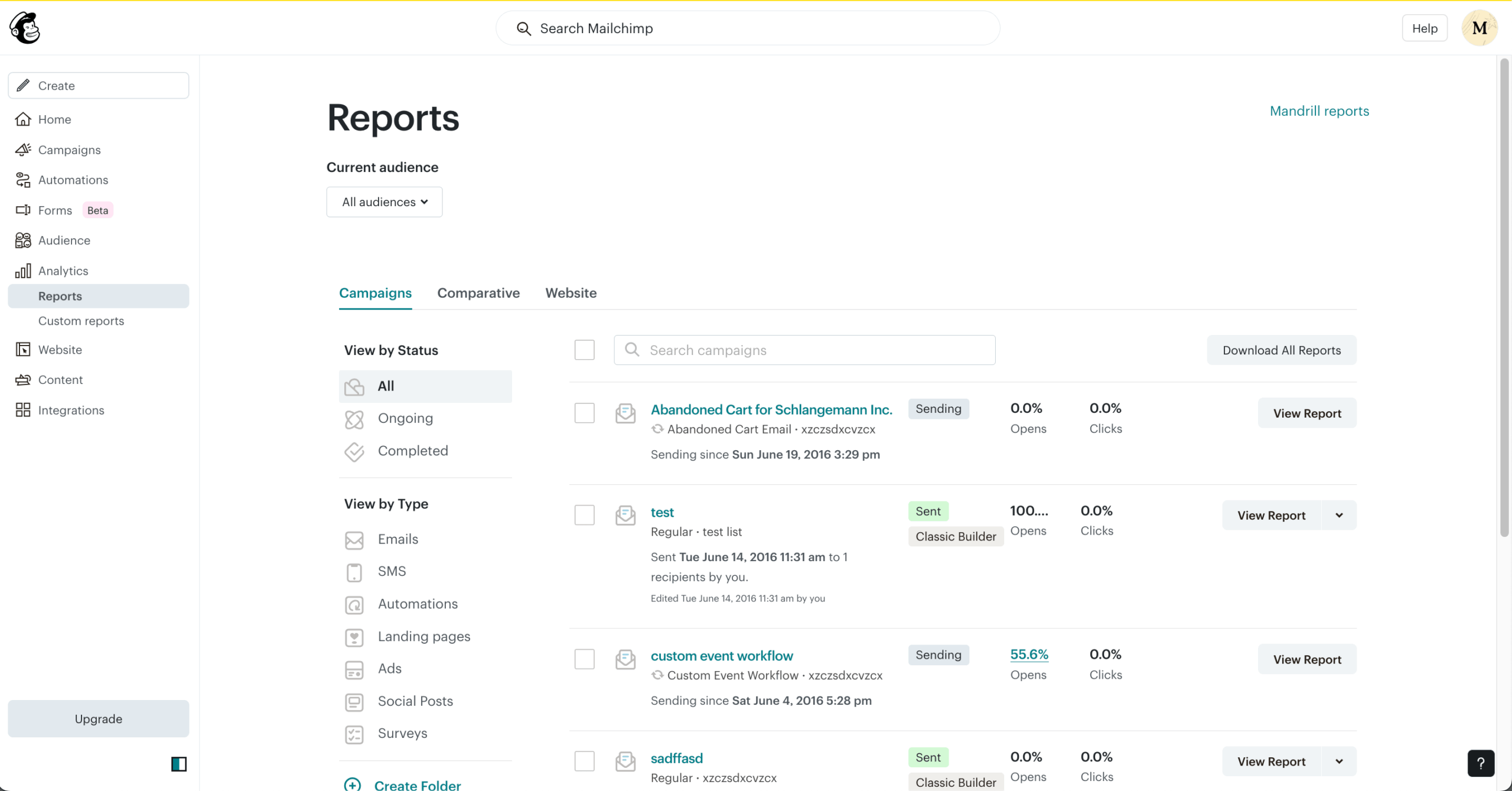
I’ve played around with the SMS integration add-on. The Mailchimp SMS messaging feature plugs into your flows with “Send SMS actions.” Different countries have different rules and sender types, so check the documentation first. When you send SMS with Mailchimp, you’re working within their ecosystem, which keeps things organized.
I use the Mailchimp texting feature as a backup channel—abandoned cart reminders, time-sensitive announcements. Reports for SMS campaigns show up alongside email metrics in Mailchimp. Make sure opt-ins are crystal clear and handle STOP requests properly—carriers don’t mess around with compliance.
Mailchimp deliverability has been solid for me—it hovered around 89% on average without dipping lower than 85% on its weaker days. The setup uses standard authentication tools: add two CNAMEs for DKIM authentication. For DMARC alignment, Mailchimp explicitly relies on DKIM alignment with your From domain.
Shared IPs work fine for most people. Dedicated IPs are available if you need them, but they require proper warming. For B2B emails, you might need to get on some allowlists. Keep your list clean, authenticate properly, and focus on good content and sending patterns rather than obsessing over IP addresses. Most email clients will receive your messages just fine with proper, full-on setup, including how Gmail notifications surface or filter your emails.
I’ve connected Mailchimp to various tools through their Integrations Directory and Marketing API v3. Here’s my experience with the main integrations:
You can schedule emails right in Mailchimp, but I use the API for more complex workflows.
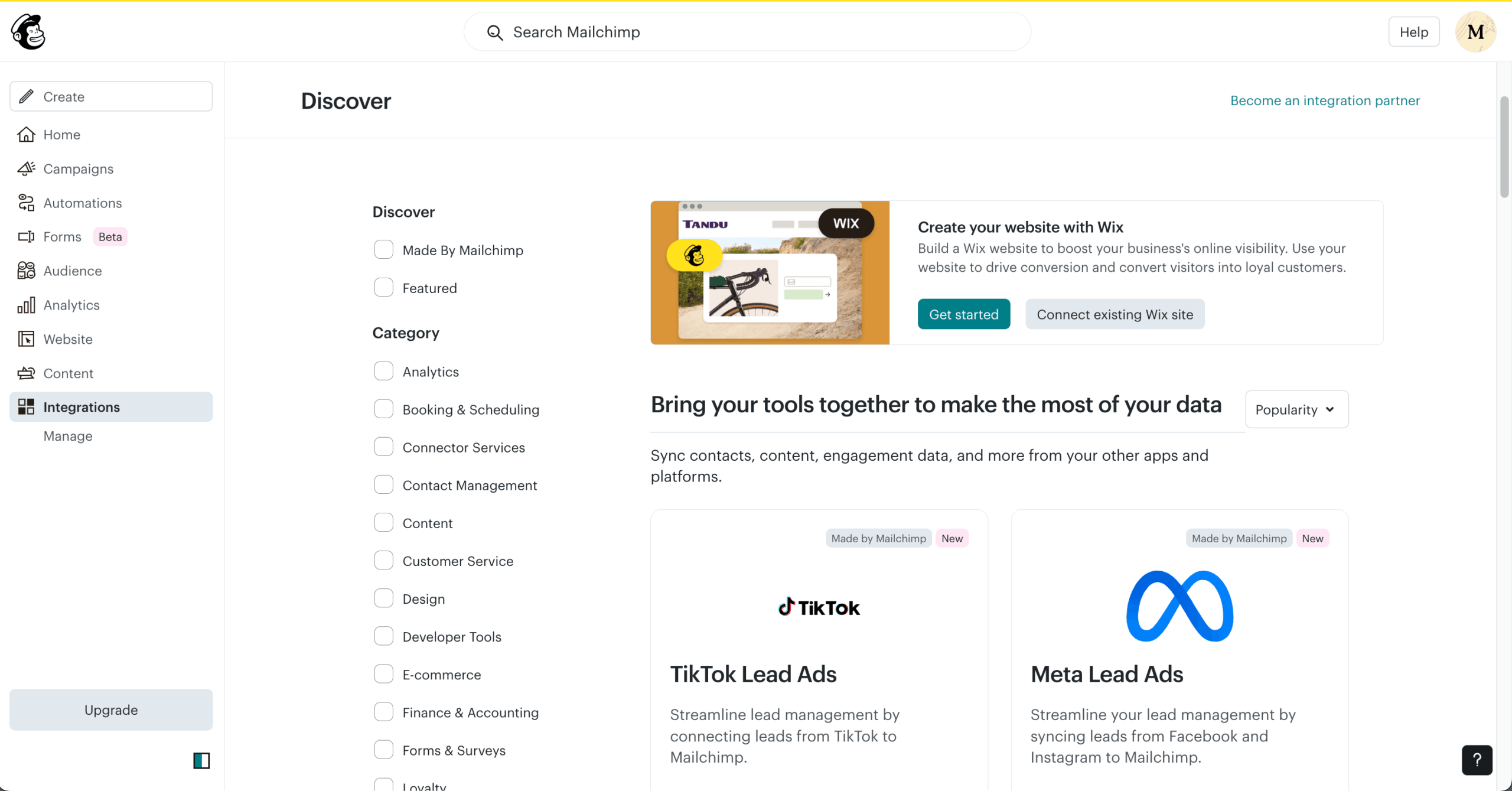
Support in Mailchimp really depends on your plan—something I didn’t fully realize until I needed help. Everyone gets access to help articles, guides, and tutorials. However, email support on the Free plan only lasts for the first 30 days. So after that you’re mostly on your own unless you upgrade.
Chat and email support kick in with paid tiers, but response times can be slow and the chatbot gatekeeping can be a little maddening. Phone support is Premium-only, and at $354/month, it’s far from a casual-budget option.
API troubleshooting is where things thin out even more. The support team will answer basic questions, but anything technical gets redirected to third-party experts. If you’re building something custom or at scale, expect to spend time—and possibly money—getting it sorted.
Free
Essentials
Standard
Premium
$0 Free forever
Starting at $13/mo for up to 500 subscribers & 5,000 emails/month
Starting at $20/mo for up to 500 subscribers & 6,000 emails/month
Starting at $350/mo for up to 150,000 emails/month (unlimited subscribers)
I touched on this before in this review, but Mailchimp’s contact charging can be baffling if you’re new to Mailchimp or forgot to read the small print.
A big gotcha is that duplicate contacts across different audiences are billed separately, so the same person in two lists counts as two contacts. It gets worse—unsubscribed contacts still count toward your bill. You have to archive or remove them to stop paying, which feels counterintuitive if you’re used to tools that only bill for active recipients.
There’s also an automatic overage billing system, so if you exceed your plan limit—even accidentally which, let’s be honest, happens even to the best of us—Mailchimp just bumps you up and charges you. Once you understand how they count contacts, you can manage it. But the billing model definitely rewards tidy list hygiene and good housekeeping.
Mailchimp excels with its user-friendly interface, generous free plan for 500 contacts, and solid email deliverability. The platform integrates seamlessly with popular tools like Shopify, WordPress, and various CRMs. Its AI-powered features genuinely help with content creation and send-time optimization, while the drag-and-drop builder makes campaign creation painless.
Costs escalate fast as your list grows, and many of the most useful automation features sit behind higher-priced tiers. For instance, free users get no live support, custom email design still needs HTML/CSS if you want anything beyond basic layouts, and after spending a considerable amount of time on the platform—the navigation feels confusing and inconsistent, still. Menus shift depending on context, and core features aren’t always where you expect them to be.
There are also notable gaps for creators. For starters, there’s no built-in monetization tools, no native paywall or newsletter revenue features. And affiliate marketing is explicitly prohibited under Mailchimp’s ToS, which rules out a major income stream for many independent publishers.
It’s a great starter platform, sure. But the deeper you go, the more it feels limiting—and expensive—as you scale.
Perfect Match For
Look Elsewhere If You’re
Small businesses and startups needing a free or low-cost starting point
Running high-volume ecommerce that needs sophisticated automation sequences
Freelancers and content creators sending regular newsletters
An enterprise team requiring advanced collaboration tools and analytics
Nonprofits and community groups with limited technical resources
A tech-focused company needing seamless integration with a custom stack
Mailchimp works great as an email marketing service for startups, freelancers, and content creators who are just getting started with email marketing. If you have under 5,000 contacts and need simple campaigns without complex automation sequences, you can use Mailchimp for small business. It’s a solid newsletter service for beginners.
If you’re technically inclined and need extensive API access, custom integrations, or want total control over your email infrastructure, other platforms offer more flexibility. Agencies managing multiple clients need better white-label options and pricing.
If you’re focused on just one channel—creators who only need email might prefer Kit, while ecommerce brands wanting deep analytics should check out Klaviyo. Budget-conscious users with growing lists should definitely compare pricing carefully before committing—platforms like Sender offer more generous free plans with automation included.
G2 Mailchimp reviews praise the same things I like: it’s easy to use, has a clean interface, and you can schedule campaigns way in advance. People appreciate the targeting, segmentation, and reporting. But they also mention the same pain points—limited support on lower tiers and weird formatting quirks in the email builder.
Reddit Mailchimp reviews like the clean UI and intuitive campaign editor. The free plan gets mentioned a lot as a good starting point. But once you need advanced features, people complain it feels too basic. Some Mailchimp reviews mention issues with automation complexity. The consensus on the Mailchimp reviews seems to be: great for beginners, but you might outgrow it.
Capterra Mailchimp reviews mention Time Warp scheduling, segmentation, and tagging as standouts. They like the interface and say delivery is reliable. Common complaints match mine: prices climb quickly, the HTML editor is inflexible, and the platform has gotten more complex over the years.
Mailchimp vs. MailerLite
I’ve used both Mailchimp vs. MailerLite. MailerLite keeps things minimal in a good way—it’s functional without the fluff and costs less. Mailchimp feels more polished though, with better integrations that made a difference for my more complex campaigns. Starting out? MailerLite might be the smarter choice. Need to scale? Mailchimp has more tools to grow with.
Mailchimp vs. Constant Contact
What about Mailchimp vs. Constant Contact? The latter works well for events and community stuff—good for nonprofits or local businesses. But Mailchimp beats it for automation, analytics, and A/B testing. If you’re building an online brand and care about ROI metrics, Mailchimp gives you more. But for events and community building, Constant Contact has some unique features.
Mailchimp vs. Kit
Finally, Mailchimp vs. Kit. The former ConvertKit was made for content creators. The automation builder is clean and logical, and subscriber tagging works really well. Mailchimp gives you more design options and better reporting though. If you just need to deliver content to subscribers, Kit’s simplicity wins. For multichannel campaigns, Mailchimp has more tools.
After using Mailchimp for years and writing this Mailchimp review, my conclusion is that Mailchimp isn’t perfect but it’s popular among email marketing services for good reasons. It manages to be accessible without being too simple, which is hard to pull off. Small businesses and growing brands get enough features without drowning in complexity.
Just be mindful of how costs can balloon as your subscriber list grows—mine certainly did. (For comparison, Sender keeps automation features available even on free plans, which Mailchimp doesn’t.) Be realistic about whether the advanced features justify the price jump compared to more specialized alternatives.
If you’re starting out or running a small to mid-sized operation, Mailchimp’s mix of usability, features, and reliability make it a solid choice. It’ll grow with you for a while. That’s been my experience anyway.
Mailchimp’s free plan gets you 500 contacts and 6,000 sends per month. Also, one audience, single user, basic templates, minimal reporting. For automation, you basically get a welcome email and an abandoned cart (if you’ve connected a store). Everything I rely on now—multi-step automations, real segmentation, A/B testing—those are all paid features.
Mailchimp’s cost depends on your contacts and how much you send. The Essentials plan starts around $13/month for 500 contacts and 5,000 monthly emails. The Standard plan is about $20/month or more. The premium plan costs way more.
Is it worth it? It depends on what you need. Mailchimp is great for beginners who want easy setup and basic automation, but costs scale quickly with list size, and advanced features require higher tiers. If you need simple tools, it’s solid— yet, power users may outgrow it fast.
Yes, Mailchimp is easy to use if you’re not entirely new to email marketing apps. The interface is clean, drag-and-drop builders work well, templates get you started fast. But there’s definitely a learning curve for complex automations, dynamic content, SMS campaigns.
The new builder vs legacy builder thing confused me initially. And hitting feature limits on lower tiers meant some unexpected upgrade decisions. It’s easy to start with, but getting good at it takes time and sometimes learning a bit of code.
Yes, unsubscribed contacts (as well as non-subscribed contacts) still count toward your total Mailchimp contact count, and therefore affect your monthly billing. This means you may be paying for contacts you’re no longer able to email, unless you archive or remove them from your contact list.
